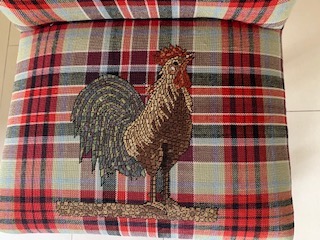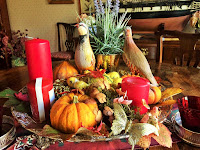Needlepoint, your passport to a Magic Carpet
It’s difficult to travel, impossible in some countries, many of us have a fear of flying - come along with me on a magic carpet ride.
For over more than 50 years I have always loved travelling to interesting destinations and seeing buildings, decorative architecture, exciting tiles or mosaic floors and, on my return, have used these memories as inspiration for my needlepoint designs.
Each design has a story, some beautiful and happy others less so. In fact, in some cases, a terrible event has befallen the area shortly after we had left.
However, as I stitch my mind wanders back – on my magic carpet – to the occasion, place and circumstances of when I first was intrigued by the scene. However, one big regret is that I have not kept a ‘travel diary’ much to my dismay now, so while putting these memories together I have sometimes resorted to Wikipedia or Google for confirmation of some detail. These sessions together have added to my knowledge and become part of my magic carpet ride.
One of my earliest inspiration was in Scotland; I extended a needlepoint course I ran in the Lake District and went onto Glasgow and the Burrell Collection. Sir William Burrell was a shipping merchant and art collector and in 1944 gave his wonderful art collection to the City of Glasgow.
Around the same period, William Randolph Hearst well known as a very successful newspaper publisher commissioned Hearst Castle in San Simeon in California with money inherited from his father. The story told is that there was great rivalry between Burrell and Hearst when acquiring works of art and particularly choice pieces were snapped up under the other one’s nose! Both of these places are wonderful places to visit.
During the visit to the Burrell Collection, a beautiful Roman mosaic of a cockerel caught my eye and sometime later – on a trip to Sweden, during the day when my husband was working I was able to work on my interpretation with a tartan background. The tartan is Huntly which is known as the Cock of the North and the chair shown here is NOT a fabric with the cockerel appliqued it was all stitched! Details, materials and illustrations are given in my book ‘Needlepoint, Stitch by Stitch’. Mosaics often inspire needlepoint, both the geometric and animal/people designs; another favourite of mine is the series in Piazza Armerina in Sicily where the Bikini Girls (4H CENTURY) is reputed to be the most replicated mosaic known; the subject, 10 young girls engaged in various gym activities clad in ‘bikinis’ didn’t inspire me to work a panel, perhaps I was wrong.On a practical note, the seat of the chair, after many years had become quite saggy; I always advise refreshing upholstery before fixing new canvas work, but in this case, the existing work was taken off, extra padding introduced and the canvas work refixed; ready to give pleasure and service for many more years
Other designs have less happy associations, Cathedral Tiles comes from encaustic wall tiles in Christchurch Cathedral in Christchurch, South Island New Zealand. We had a lovely trip there, but shortly after returning home in 2011, they suffered a tremendous earthquake and much of the city including the Cathedral were destroyed. Since then a transitional pro-cathedral constructed in cardboard has been built including a dramatic area of stain glass has been installed – well shown on the Google site.
Another sad story linked to Syria; we returned to the UK only days before the bitter Syrian Civil War broke out. My memories of all those ancient buildings still haunt me but in particular the ceiling in the Throne Room in the medieval Citadel in Aleppo which we visited on a sunny day with no premonition of the disasters to come. In fact, I found an exciting shop specialising in decorative chains; certain that friends were planning on a visit in the near future I purchased some samples with the intension of getting more if they proved suitable for the leather clutch bags I design. Sadly they were unable to visit, worse still I didn’t get more chain!
So I hope that looking at my website you will understand from the names of each design my love for translating them into needlepoint.
Another of my favourite pieces is ‘The Basket Makers of Road Town, Tortola. We have, for the last four years, spent time in the BVIs, impossible with lock-down so my interpretation of a watercolour by Jill Tattersall reminds me of those lovely sunny days and friendly people.
The other travel I love, on the magic carpet, is time travel. Needlepoint has been practiced for decoration, utility and I believe to while away the hours in centuries past as we do now.
Working my own Florentine pieces, I imagine the Elizabethan ladies stitching, frequently large pieces such as bed hangings or even complete wall hangings for a room. A truly spectacular example is the Mary Queen of Scots’ bed hangings at Parham House an Elizabethan house in Sussex. Florentine is my choice of the moment and I am enjoying playing with traditional patterns in vibrant colours and in this Citron Gris design marrying Florentine with Victorian Pattern Darning both traditional techniques with a modern twist.
Around that time printed pattern books and herbals became available and avid embroiderers copied animals in particular with no idea of their size so a lion could be a similar size to a snail. I believe that Durer made his series of woodcuts without ever seeing a rhinoceros!
Much later on both sides of the Atlantic dame schools offered needlework as an important part of their training along with music and painting. Geography was learned by stitching maps; in my collection, there is one stitched by Ann Pearson in 1782; sadly, under glass, it is difficult to share it with you
Another genre is samplers like the Mary Dowell Sampler. She was a 19 century Vicar’s wife living in Norfolk who invited all her house guests to stitch a small motif between the years 1830 and 1870 and joined them all together to form a record of the changing fashions, topics of interest and useful repeating patterns - a fascinating record that has been on display on both sides of the Atlantic.
Finally, I’ve already mentioned using Google, Wikipedia and the like to follow up on various themes I have mentioned; as a young child I vividly remember the Encyclopaedias Britannia and spending many hours following up a trail on a particular subject; now with the same passion and enthusiasm, I love following subjects, people and events that add greatly to my knowledge and understanding of a situation.






Comments
Post a Comment